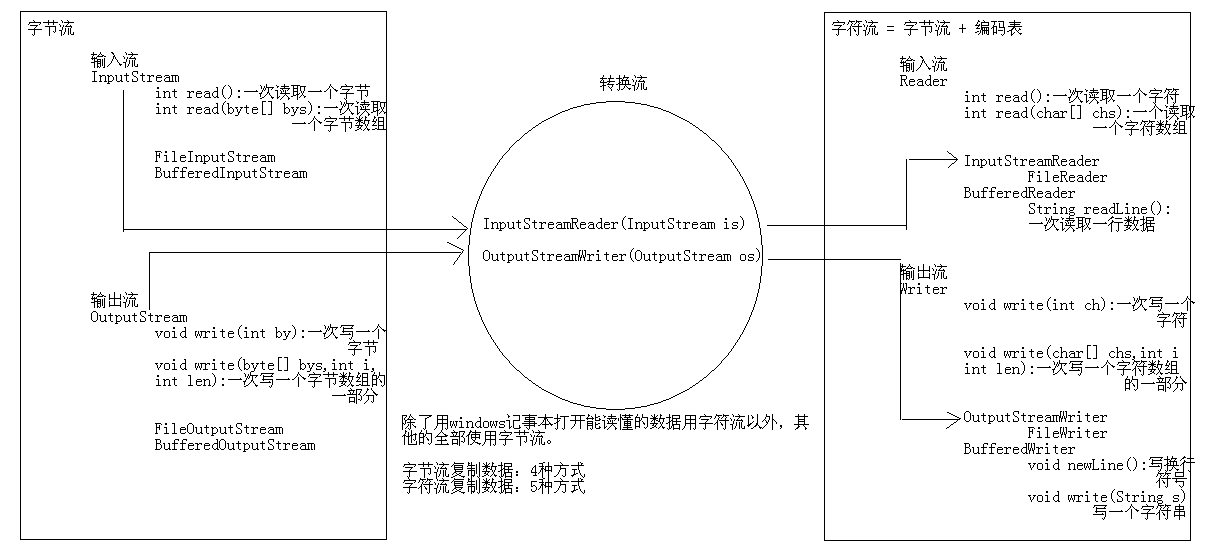java IO流简介 java IO流可 分为输入流 和 输出流。这里的输入和输出是相对于程序而言的,外部数据输入到程序中时,我们用输入流,程序中的数据输出到外部时,我们用输出流。
输入流又可分为字节输入流和字符输入流。字节输入流的基类为InputStream,我们常用到它的子类FileInputStream, 字符输入流的基类为Reader,我们常用到它的子类FileReader。
输出流又可分为字节输出流和字符输出流。字节输出流的基类为OutputStream,我们常用到它的子类FileOutputStream, 字符输出流的基类为Writer,我们常用到它的子类FileWriter。
那什么时候该用字节流,什么时候该用字符流呢?
一般来说,在输入输出一些二进制对象的时候比如图片,音乐,视频文件,我们用字节流。 在输入输出一些文本文件的时候比如文字,我们用字符流。字符其实可以理解为是字节+对应的编码表(utf-8,gbk等)构成的,相同的一段字节,用不同的编码格式,最后得到的字符是不一样的(生活常见的乱码就是这样产生的)
另外,java在字节流和字符流中间提供了一层吧转换流,,可以将字节流转化为字符流。输入的转换流为InputStreamReader(InputStream is),输出的转换流为OutputStreamReader(OutputStream os )。
解释了这么多,不如用一图来总结一下:
IO 流在代码中的实际应用 java提供了操作IO流的API,在代码中如何使用呢? 接下来,直接附上几个比较实用的demo,可参考运用到自己的代码里
1 2 3 4 5 6 7 8 9 10 11 12 13 14 15 16 17 18 19 20 21 22 23 24 25 26 27 28 29 30 31 32 33 34 35 36 37 38 39 40 41 42 43 44 45 46 47 48 49 50 51 52 53 54 55 56 57 58 59 60 61 62 63 64 65 66 67 68 69 70 71 72 73 74 75 76 77 78 public class CopyMp3Demo { public static void main(String[] args) throws Exception { long start = System.currentTimeMillis(); method1("e:\\music.mp3", "copy1.mp3"); method2("e:\\music.mp3", "copy2.mp3"); method3("e:\\music.mp3", "copy3.mp3"); method4("e:\\music.mp3", "copy4.mp3"); long end = System.currentTimeMillis(); System.out.println(" 总共耗时:" + (end - start) + "毫秒"); } // 基本字节流一次读写一个字节 public static void method1(String src, String dest) throws Exception { FileInputStream fis = new FileInputStream(src); FileOutputStream fos = new FileOutputStream(dest); int by = 0; while ((by = fis.read()) != -1) { fos.write(by); } fis.close(); fos.close(); } // 基本字节流一次读写一个字节数组 public static void method2(String src, String dest) throws Exception { FileInputStream fis = new FileInputStream(src); FileOutputStream fos = new FileOutputStream(dest); int len = 0; byte[] bys = new byte[1024]; while ((len = fis.read(bys)) != -1) { fos.write(bys, 0, len); } fis.close(); fos.close(); } // 高效字节流一次读写一个字节: public static void method3(String src, String dest) throws Exception { BufferedInputStream bis = new BufferedInputStream(new FileInputStream(src)); BufferedOutputStream bos = new BufferedOutputStream(new FileOutputStream(dest)); int by = 0; while ((by = bis.read()) != -1) { bos.write(by); } bis.close(); bos.close(); } // 高效字节流一次读写一个字节数组: public static void method4(String src, String dest) throws Exception { BufferedInputStream bis = new BufferedInputStream(new FileInputStream(src)); BufferedOutputStream bos = new BufferedOutputStream(new FileOutputStream(dest)); int len = 0; byte[] bys = new byte[1024]; while ((len = bis.read(bys)) != -1) { bos.write(bys, 0, len); } bis.close(); bos.close(); } }
这里我们的目的是利用IO流将E盘根目录下的music.mp3文件拷贝到项目工程目录下,前面说了,拷贝音乐文件用字节流,这里提供了四种拷贝方式,可以比较拷贝所需时间,其中第一种方式(基本字节流一次读写一个字节 )最慢,第四种(高效字节流一次读写一个字节数组)最快,中间两种差不多。
说一下这里的BufferedInputStream是输入流(对应的输出流BufferedOutputStream)的缓冲流,又称装饰流,一般我们建议在基本流外面包上装饰流,因为这样可极大提升效率。
1 2 3 4 5 6 7 8 9 10 11 12 13 14 15 16 17 18 19 20 21 22 23 24 25 26 27 28 29 30 31 32 33 34 35 36 37 38 39 40 41 42 43 44 45 46 47 48 49 50 51 52 53 54 55 56 57 58 59 60 61 62 63 64 65 66 67 68 69 70 71 72 73 74 75 76 77 78 79 80 81 82 83 84 85 86 //字符流读写数据的五种方式 public class CopyTxtDemo { public static void main(String[] args) throws IOException { String SrcString = "a.txt"; String DestString = "b.txt"; // method1(SrcString,DestString); // method3(SrcString,DestString); // method4(SrcString,DestString); method5(SrcString, DestString); } // 基本字符流一次读写一个字符 private static void method1(String srcString, String destString) throws IOException { FileReader fr = new FileReader(srcString); FileWriter fw = new FileWriter(destString); int len = 0; while ((len = fr.read()) != -1) { fw.write(len); } fr.close(); fw.close(); } // 基本字符流一次读写一个字符数组 private static void method2(String srcString, String destString) throws IOException { FileReader fr = new FileReader(srcString); FileWriter fw = new FileWriter(destString); char[] chs = new char[1024]; int len = 0; while ((len = fr.read(chs)) != -1) { fw.write(chs, 0, len); } fr.close(); fw.close(); } // 高效字符流一次读写一个字符 private static void method3(String srcString, String destString) throws IOException { BufferedReader br = new BufferedReader(new FileReader(srcString)); BufferedWriter bw = new BufferedWriter(new FileWriter(destString)); int len = 0; while ((len = br.read()) != -1) { bw.write(len); } br.close(); bw.close(); } // 高效字符流一次读写一个字符数组 private static void method4(String srcString, String destString) throws IOException { BufferedReader br = new BufferedReader(new FileReader(srcString)); BufferedWriter bw = new BufferedWriter(new FileWriter(destString)); char[] chs = new char[1024]; int len = 0; while ((len = br.read(chs)) != -1) { bw.write(chs, 0, len); } br.close(); bw.close(); } // 高效字符流一次读写一行 private static void method5(String srcString, String destString) throws IOException { BufferedReader br = new BufferedReader(new FileReader(srcString)); BufferedWriter bw = new BufferedWriter(new FileWriter(destString)); String len = null; while ((len = br.readLine()) != null) { bw.write(len); bw.newLine(); bw.flush(); } br.close(); bw.close(); } }
上面代码的目的是将项目工程下的“a.txt”文件拷贝到b.txt里。前面说了拷贝文本文件用字符流。前四种拷贝方式就不说了,跟字节流差不多,第五种比较特殊,一次读写一行。
注意:上述代码最好加上try–catch,并在finally里关闭流。如下:
1 2 3 4 5 6 7 8 9 10 11 12 13 14 15 16 17 18 19 20 21 22 public static void method3 (String src, String dest) throws Exception BufferedInputStream bis =null ; BufferedOutputStream bos = null ; try { bis = new BufferedInputStream(new FileInputStream(src)); bos = new BufferedOutputStream(new FileOutputStream(dest)); int by = 0 ; while ((by = bis.read()) != -1 ) { bos.write(by); } } catch (Exception e) { e.printStackTrace(); }finally { bos.close(); bis.close(); } }

